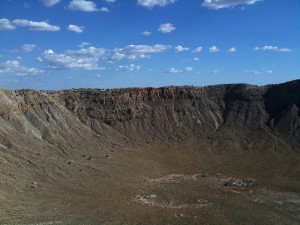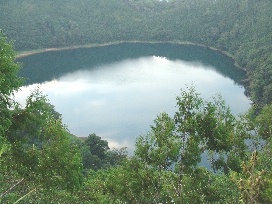Tag: Guessman
Falling Meteors and Glowing Pterosaurs
by admin on Sep.29, 2010, under Environment, Strange
Meteor Crater, known by scientists as “Barringer Crater,” forty-three miles east of Flagstaff, Arizona, is now recognized as a meteorite impact crater; but for decades it was believed to have been caused by a volcanic explosion. Daniel Barringer, early in the twentieth century, suggested that the crater came from a large meteor collision with earth. Skepticism continued until the middle of the twentieth century, when is was proven that an impact was involved, not any form of volcanism. Science rarely remains dormant for long, as scientists replace old theories with new.
is now recognized as a meteorite impact crater; but for decades it was believed to have been caused by a volcanic explosion. Daniel Barringer, early in the twentieth century, suggested that the crater came from a large meteor collision with earth. Skepticism continued until the middle of the twentieth century, when is was proven that an impact was involved, not any form of volcanism. Science rarely remains dormant for long, as scientists replace old theories with new.
In October of 2004, at about 10 p.m., on Umboi Island (known by natives as “Siasi”), in Papua New Guinea, David Woetzel, an American cryptozoologist, was searching the sky for any sign of the flying animal that natives call “ropen.” He and his American associate Garth Guessman, had been searching in vane for days, but their luck now changed. Woetzel saw something bright flying almost horizontally, toward a crater lake a few miles away. What was flying? He said, “. . . almost golden and shimmering around the edges. . . . There was no [meteor] tail.” It was large enough to have had a long tail, if it had been a meteor, for Woetzel also described the angular-size as about 20%-25% the size of a full moon. But the place where the flying light disappeared is significant, for it strongly suggests what that light was.
Papua New Guinea, David Woetzel, an American cryptozoologist, was searching the sky for any sign of the flying animal that natives call “ropen.” He and his American associate Garth Guessman, had been searching in vane for days, but their luck now changed. Woetzel saw something bright flying almost horizontally, toward a crater lake a few miles away. What was flying? He said, “. . . almost golden and shimmering around the edges. . . . There was no [meteor] tail.” It was large enough to have had a long tail, if it had been a meteor, for Woetzel also described the angular-size as about 20%-25% the size of a full moon. But the place where the flying light disappeared is significant, for it strongly suggests what that light was.
A few weeks before the Woetzel-Guessman expedition, the American cryptozoologist Jonathan Whitcomb was exploring Umboi Island (but only in the south-central area). He found three eyewitnesses who had seen the giant ropen flying in daylight. Where? Over Lake Pung. The flying creature was described as without any feathers, with a tail “seven meters” long, and a mouth “like a crocodile.”
So how does this strange giant-pterosaur-like creature (natives call it “ropen”) relate to the strange light flying towards this crater lake, a few weeks after the interviews of these eyewitnesses? Other eyewitnesses were interviewed by Woetzel, Guessman, and Whitcomb, and some of them described the creature that they had seen: a large flying creature that was glowing as it was flying over Umboi Island. Apparently the ropen has an extraordinary bioluminescent capacity, revolutionary to modern concepts of bioluminescence. But science does progress, as extraordinary as is the concept of a modern bioluminescent pterosaur.
Dinosaurs in Papua New Guinea?
by admin on Feb.23, 2010, under Strange
New species, giant rats and strange frogs, being discovered in New Guinea—that now seems commonplace. New Guinea is the second largest island on the planet (after Greenland) and perhaps the least explored. But look just a bit to the east, on New Britain Island: Over the years, eyewitnesses have reported three types of giant dinosaurs and a pterosaur. Extraordinary!
The second largest island in the nation of Papua New Guinea, New Britain, covers 14,600 square miles, mostly tropical rain forest. Before the 20th Century, the interior of the island had been mostly unexplored by outsiders. But by 2009, several astonishing cryptozoological investigations had taken place.
The MonsterQuest Papua New Guinea expedition of 2009 (it was short)–that was not one of them, for it appeared practically a foregone conclusion that the expedition team would discover no pterosaur but only reaffirm their bat-explanation. According to one member of the team, they were there to make a show, not to do scientific research.
A more-enduring endeavor, a medical mission deep in the interior of the island, unintentionally gave cryptozoologists much more to talk about, for the eyewitnesses were focused on helping local natives rather than inspiring American cryptozoologists. Garth Guessman (who has explored in Papua New Guinea twice, searching for “living fossils”) interviewed the three eyewitnesses, in 2006, after they had returned to the Unites States. They described a featherless creature, with a head crest but without any long tail, “soaring” for up to half a mile in daylight; the Pterodactyloid-like creatures fly regularly over one valley, sometimes in a small group. It obviously differs from the nocturnal, solitary long-tailed ropen of Umboi Island.
Leaving the pterosaurs, what about a ten-foot-tall grey-colored creature with a head like a dog and a tail like a crocodile? This was not millions of years ago but in 2004. “Christine Samei told reporters she saw the ‘dinosaur‘ early on Wednesday in a marsh just outside . . . Kokopo . . . New Britain.” After hearing others talk about it, she went to see for herself; “very huge and ugly looking,” she said. Michael Tarawana, a local leader, told a newspaper reporter that the creature had eaten three dogs. That sounds like something a tyrannosaurus rex might do.
But near the coast of southwest New Britain, two different dinosaur-like creatures have been observed by natives. According to the Australia explorer Brian Irwin, Dililo Island (near Gasmata) has an apparent sauropod dinosaur, seen one afternoon late in 2005; the length was estimated at “about 20 metres” (over 60 feet). And Umbungi Island has an apparent Therizinosaurus, seen “occasionally,” and with length estimated at “10–15 metres” (about 40 feet).
New Britain Island deserves more scientific expeditions, even if only one of these creatures is officially discovered and verified a living fossil.

